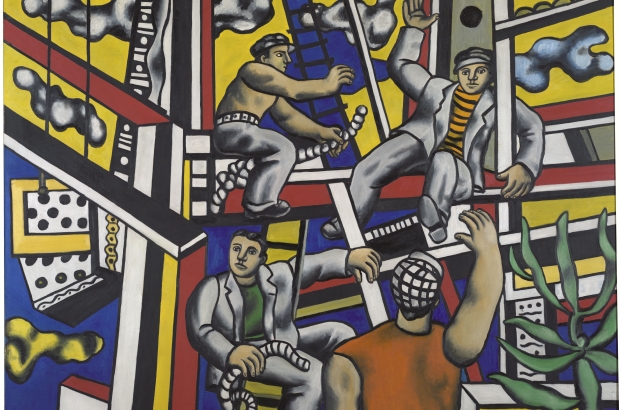- Daily & Weekly newsletters
- Buy & download The Bulletin
- Comment on our articles
Exhibition bridges striking visions of post-war Europe
Having traversed 12 exhibition rooms, I find myself in front of “Bather (Cain)”. The oil painting by the German Harald Metzkes depicts Adam and Eve’s first son who murdered his younger brother out of envy and wrath. Metzkes drew inspiration from the Soviet invasion of Czechoslovakia in 1968.
This powerful image concludes Facing the Future: Art in Europe 1945-68, an exhibition that left me with mixed feelings. Sure, there is some great art on display – including the works of Lucio Fontana, Yves Klein and Otto Muehl – but the whole feels more like a meticulously constructed academic exercise.
The exhibition comprises some 160 works – most of them paintings – by 150 artists. It’s divided into six chronological sections, some with an artistic link, others philosophical. When Bozar’s director, Paul Dujardin, says it was a hell of a job to collect all the pieces, you take his word for it, but Facing the Future nevertheless lacks some crucial names.
Though the aim was not to showcase the best of the best, and the overarching narrative is more important than the individuals presented, I was left with the question of how it could be possible to present post-war European art without the likes of Francis Bacon, Pierre Soulage, Barbara Hepworth or David Hockney.
That’s not to say the exhibition lacks bite. On the contrary, its power lies in the fact that it’s not limited to Western Europe but showcases many visual artists from behind the Iron Curtain, most of whom will be familiar only to art historians.
Shared vision
There has already been plenty of discussion on the main differences between the art worlds of Western and Eastern Europe in the Cold War. In the West, freedom reigned, resulting in abstract expressionism, but in the East, the artists were shackled by the premises of socialist realism. The exhibition, which will later travel to Karlsruhe in Germany and Moscow, wants to erase this difference.
Eckhart Gillen, one of the curators, illustrates this by comparing two prominent works, “Builders (builders with aloe)” (pictured) by Frenchman Fernand Léger and “Sketch for Peaceful Building” by the Soviet painter Alexander Deyneka.
“They share the theme of construction workers,” he says. “Deyneka is a typical example of a painter glorifying the working ethos: the joyful labourers are building the country. But Léger, who was a member of the communist party, also presents an optimistic view of the future.”
It’s a common trait of European art in the 1960s, he adds, propelled by new technologies and the prospects of nuclear power.
Still, other artists shared a much darker vision of the future. Gillen brings up the painter Armando, who started off as a member of the avant-garde movement Cobra. In Facing the Future, the Dutch painter’s work is of a radically different sort.
“Black Barbed Wire on Black 1-62” is a black rectangular painting with actual barbed wire wrapped around the canvas. The chilling work is undoubtedly one of the show’s highlights. “Armando grew up in the shadows of the concentration camp in Amersfoort, where he was confronted with barbed wire day in, day out,” Gillen says.
Towards the future
The artworks illustrate the duality of post-war European art. The Second World War enveloped the world of art with the vision of doom and suffering, so strikingly illustrated by Armando and others. On the other hand, a new optimism was blossoming among artists who weren’t afraid to inject joy and fun into their work.
As early as 1948, Scotsman Eduardo Paolozzi would lay the groundwork for the movement that would come to be known as Pop art, favouring a confident belief in the future by combining the elements of popular culture, like magazines and advertisements in his paper collage “Dr. Pepper”.
Even in the 1960s, when the shadow of the Second World War began to fade, the dichotomy persisted. The playfulness of François Morellet’s optical art contrasts sharply with the imagery of war used by AR Penck or Ilya Kabakov.
But by the second half of the decade, even the strongest optimists began to lose hope, as the prosperity and happiness envisioned by unbridled consumerism turned out to be a hopeless dream. With the Vietnam War raging, it became clear that the world post-1968 would never be the same.
The exhibition ends on this iconic year. Combined with the immense book spanning nearly 500 pages of text and illustration, it’s a worthy introduction to the world of art in post-Second World War Europe. And, as a didactic exercise, it surely can’t be surpassed. Who knows, maybe one day another exhibition will pick up where this one left off.
Until 25 September, Bozar, Brussels. Photo: Fernand Léger, Builders with Aloe, 1951 ©SABAM Belgium









